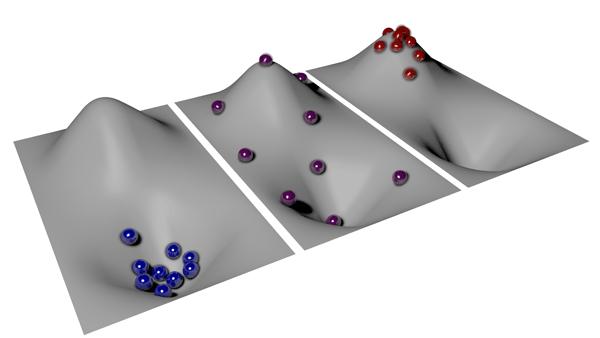German researchers have generated “negative temperatures” they say are hotter than infinity, with applications for over-100-percent efficient engines, and insights into dark energy.
At the hypothetical temperature of zero kelvin (minus 459.67 degrees Fahrenheit), atoms would stop moving, so in theory nothing can be colder than absolute zero kelvin.
But negative temperatures can exist on a scale that is looped instead of linear. When temperatures go either below zero or above infinity on the positive region of this scale, they become negative.
With positive temperatures, atoms are more likely occupy low-energy states than high ones, a pattern called the Boltzmann distribution. When heated, atoms can reach higher energy levels.
“The inverted Boltzmann distribution is the hallmark of negative absolute temperature, and this is what we have achieved,” said study co-author Ulrich Schneider at the University of Munich in a press release. “Yet the gas is not colder than zero kelvin, but hotter.”
“It is even hotter than at any positive temperature—the temperature scale simply does not end at infinity, but jumps to negative values instead.”
Objects with negative temperatures behave strangely, for example energy flows from them to ones with positive temperature.
The researchers created a system that limits atoms’ energy by cooling about 100,000 atoms to a few nanokelvin, or billionth of a kelvin in a vacuum chamber, using a web of laser beams or “optical lattice,” and magnetic fields to control their behavior and shift them into a negative temperature zone.
Temperature depends on pressure, and the atoms’ movement and potential energy. The gas was given a negative pressure, the lattice limited their potential energy, and the magnetic fields made them repulsive.
Matter at negative absolute temperatures could be used to create heat engines with over 100-percent efficiency that could absorb energy from cold substances as well as hot ones.
It also has relevance in cosmology as its thermodynamic behavior is similar to the properties of dark energy—believed to be accelerating the universe’s expansion—as the negative pressure of the cold gas means it should collapse, but its negative temperature prevents this happening.
The study was published in Science on Jan. 4.
The Epoch Times publishes in 35 countries and in 20 languages. Subscribe to our e-newsletter.

Friends Read Free